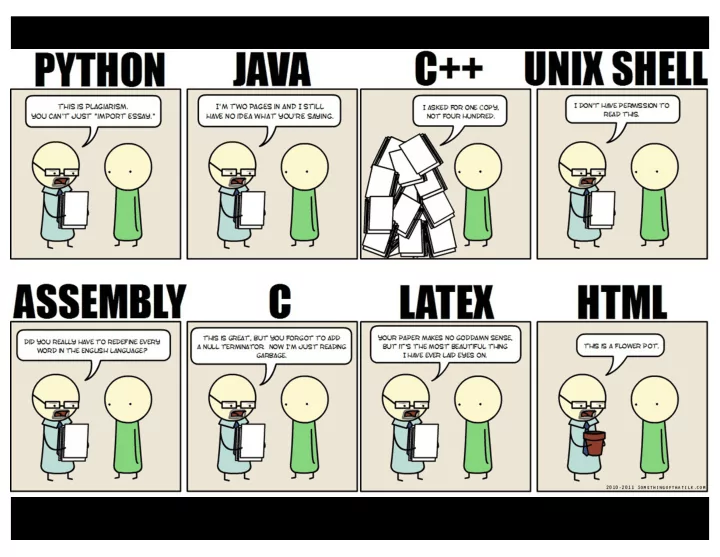

CS 152: Programming Language Paradigms Higher Order Functions Prof. Tom Austin San José State University
Functional languages treat programs as mathematical functions .
Definition: A function is a rule that associates to each x from some set X of values a unique y from a set of Y values. y = f(x) f is the name of the function
Definition: A function is a rule that associates to each x from some set X of values a unique y from a set of Y values. x is a variable in the set X y = f(x) X is the domain of f. x ∈ X is the independent variable.
Definition: A function is a rule that associates to each x from some set X of values a unique y from a set of Y values. Y is the range of f. y = f(x) y ∈ Y is the dependent variable. y is a variable in the set Y
Qualities of Functional Programing 1. Functions clearly distinguish inputs from outputs 2. No assignment (pure) 3. No loops (pure) 4. Result depends only on input values – Evaluation order does not matter 5. Functions are first class values
Referential transparency In purely functional programs you can • replace an expression with its value • write code free of side-effects
Functions are first-class data values. We can do anything with them that we can do with other values.
Higher-order function A function that • takes functions as arguments; or • returns a function as its result; or • dynamically constructs new functions
Higher-order functions example (in class)
Lab 3: map and filter See Canvas for a more detailed explanation. 1. Using map , implement strings-to-nums . (strings-to-nums '("1" "2")) -> '(1 2) 2. Using map , create a make-names function: 1. input: list of first names, list of last names 2. output: list of full names 3. Using the filter function, write a function that takes a list of employees and returns a list containing only managers.
Fold variants • foldr – Traverses from the right – (foldr * 1 '(2 4 8)) is the same as (* 2 (* 4 (* 8 1))) • foldl – Traverses from the left – (foldl * 1 '(2 4 8)) is the same as (* 8 (* 4 (* 2 1))) • WARNING: Different languages define fold slightly differently.
foldr evaluation (foldr cons '() '(1 2 3)) -> (cons 1 (foldr cons '() '(2 3))) -> (cons 1 (cons 2 (foldr cons '() '(3)))) -> (cons 1 (cons 2 (cons 3 (foldr cons '() '())))) -> (cons 1 (cons 2 (cons 3 '()))) -> (cons 1 (cons 2 '(3))) -> (cons 1 '(2 3))) -> '(1 2 3)
foldl evaluation (slightly inaccurate – emphasizing order of operations) accumulator (foldl cons '() '(1 2 3)) -> (foldl cons (cons 1 '()) '(2 3)) -> (foldl cons (cons 2 (cons 1 '())) '(3)) -> (foldl cons (cons 3 (cons 2 (cons 1 '()))) '()) -> (cons 3 (cons 2 (cons 1 '()))) -> (cons 3 (cons 2 '(1))) -> (cons 3 '(2 1)) -> '(3 2 1)
foldl evaluation (accurate version) (foldl cons '() '(1 2 3)) -> (foldl cons (cons 1 '()) '(2 3)) -> (foldl cons '(1) '(2 3)) -> (foldl cons (cons 2 '(1)) '(3)) -> (foldl cons '(2 1) '(3)) -> (foldl cons (cons 3 '(2 1)) '()) -> (foldl cons '(3 2 1) '()) -> '(3 2 1)
Tail Recursion Iterative solutions tend to be more efficient than recursive solutions. However, compilers are very good at optimizing a tail recursive functions.
In tail recursion, the recursive call is the last step performed before returning a value.
Is this function tail-recursive? public int factorial(int n) { if (n==1) return 1; else { return n * factorial(n-1); } } No: the last step is multiplication
Is this function tail-recursive? public int factorialAcc(int n, int acc){ if (n==1) return acc; else { return factorialAcc(n-1, n*acc); } } Yes: the recursive step is the last thing we do
Which version is tail-recursive? (define (fact n a) (define (fact n) (if (= n 1) (if (= n 1) a 1 (* n (fact (fact (- n 1) (- n 1))))) (* n a))))
Lab 4: foldl and foldr See Canvas for details.
Recommend
More recommend